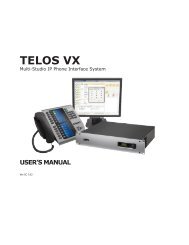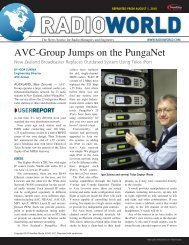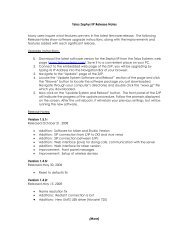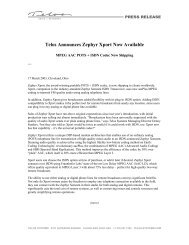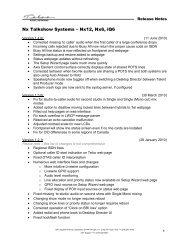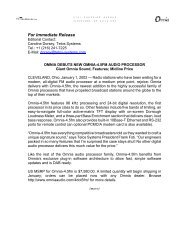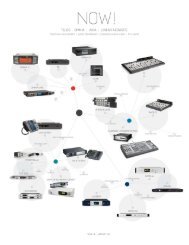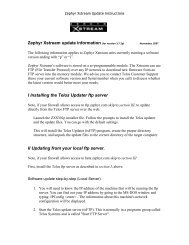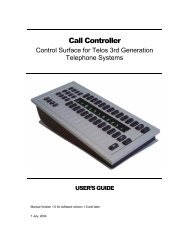Hx1-Hx2 Manual-1.4.1 - Telos
Hx1-Hx2 Manual-1.4.1 - Telos
Hx1-Hx2 Manual-1.4.1 - Telos
Create successful ePaper yourself
Turn your PDF publications into a flip-book with our unique Google optimized e-Paper software.
TelepHone TerMInoloGy GuIDe | A3<br />
Calling Line ID- See CLID. See also Caller ID.<br />
Calling Party Control- See CPC.<br />
Call Progress Tones – Tones used in the telephone network to indicate call status or progress<br />
through the network. This includes dial tone, ring back tone, re-order (or fast busy) tone, Special<br />
Information Tones (SIT’s), etc. The <strong>Telos</strong> Hx can be set to listen for these tones and disconnect<br />
when one is heard if CPC is not available or is unreliable.<br />
CAS -Channel Associated Signaling. A bit-based signaling method used on digital lines (such<br />
as T1) that is periodically inserted into the low order bit also used for the audio transmission.<br />
See Robbed Bit Signaling.<br />
CCIS- Common Channel Interoffice Signaling. A signaling system where network information<br />
such as address and routing information are handled externally to the actual communications<br />
(voice) path. SS7 (Signaling System 7) is the internationally standardized CCIS system.<br />
Deployment of CCIS increased efficiency since no communications (voice) channels are used<br />
merely to report an “all trunks busy” or “far end busy” conditions. It also decreased toll fraud<br />
substantially since it removed the potential for access to the signaling information that was<br />
inherent to in-band signaling schemes. CCIS also enables CLASS features as well as sophisticated<br />
re-routing features for “intelligent network” applications. See also in-band signaling. See<br />
also SS7.<br />
Central Office- See CO.<br />
Centrex - Central Exchange Service. An enhanced business telephone service intended to offer<br />
most of the features of a PBX but where the lines are all from the LEC out of a public switch.<br />
Offers CLASS-like features for business users such as 4-digit “inside” dialing, hold, transfer,<br />
attendant, etc.<br />
CEPT- Conference on European Posts & Telecommunications. This is a European standards<br />
body that formerly set the standards for telephone interfaces for 26 countries.<br />
CEPT Format- The usual rate and frame format for E1 circuits. 2.048 mbps. See E1.<br />
CEPT Rate- See CEPT format. See also E1.<br />
Channel Associated Signaling- See CAS. See also Robbed Bit Signaling.<br />
Channel Bank - a device that multiplexes or demultiplexes a group of communications channels,<br />
such as analog or digital telephone lines, into one channel of higher bandwidth or higher<br />
digital bit rate, such as a DS-1 (T1) circuit. See also Pair Gain.<br />
Choke Exchange- A telephone exchange, which is assigned to Radio and TV stations, Promoters,<br />
and other users that will be receiving large numbers of simultaneous calls. The idea is to<br />
group all of these users on a single exchange so when all routes into that exchange are in use<br />
“normal” users (on other exchanges) will not experience blocking of incoming or outgoing calls.<br />
Trunks from other local exchanges into the choke exchange are deliberately limited to just a few<br />
paths so callers will get an “all trunks busy” instead of completely blocking their local exchange.<br />
However, when one of the choke exchange users experiences a large number of calls (as when<br />
your station runs a contest) the other choke exchange users will be blocked because all trunks<br />
into the choke exchange will be busy. In the modern network, using CCIS signaling such as<br />
SS7, actual trunks are not used to convey “busy” or “all trunks busy” conditions. Thus blocking<br />
due to a station contest should not occur as the busy status in response to a call attempt is<br />
conveyed over the separate SS7 network. Therefore, the need for choke exchanges has pretty<br />
much disappeared. Nonetheless, many Telcos still insist that Broadcasters use special choke lines<br />
for call-in lines. Much of the need for the “choke network” is historical. Few current telephone<br />
company employees understand this or it’s history. They only seem to believe that it’s “required”.




